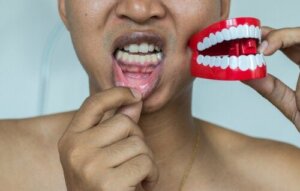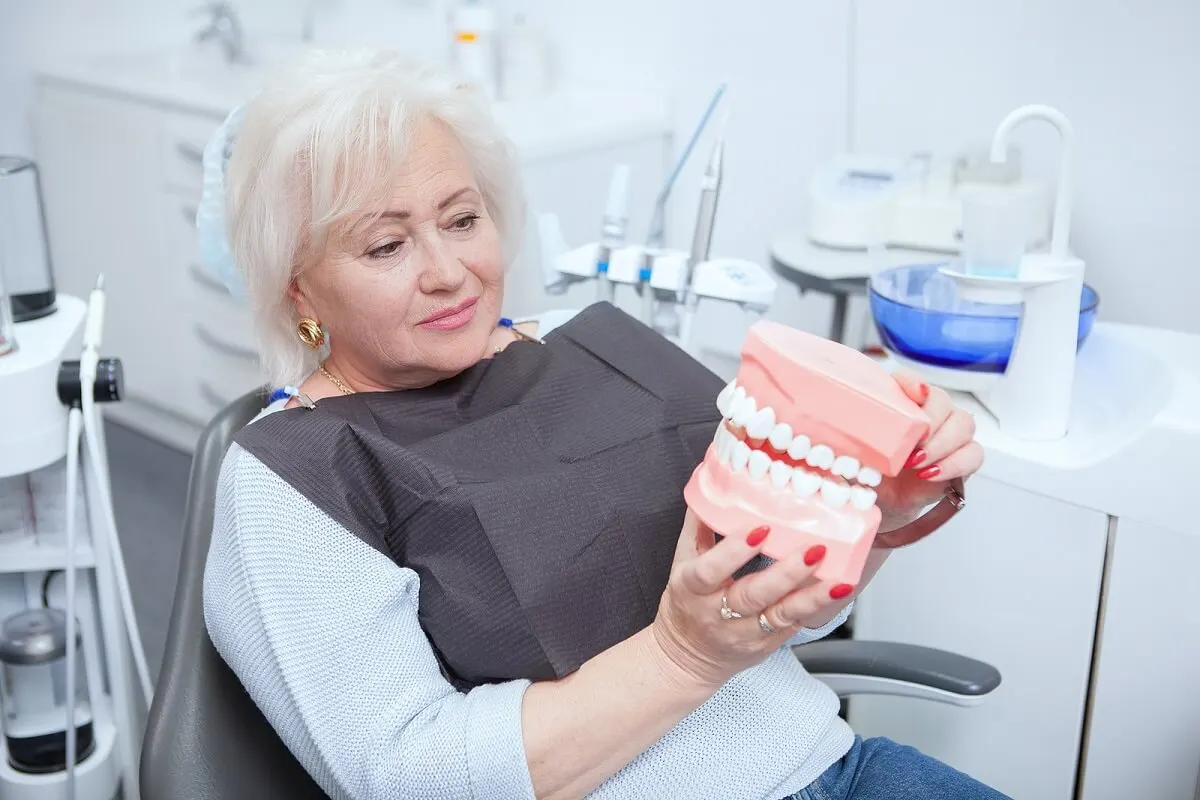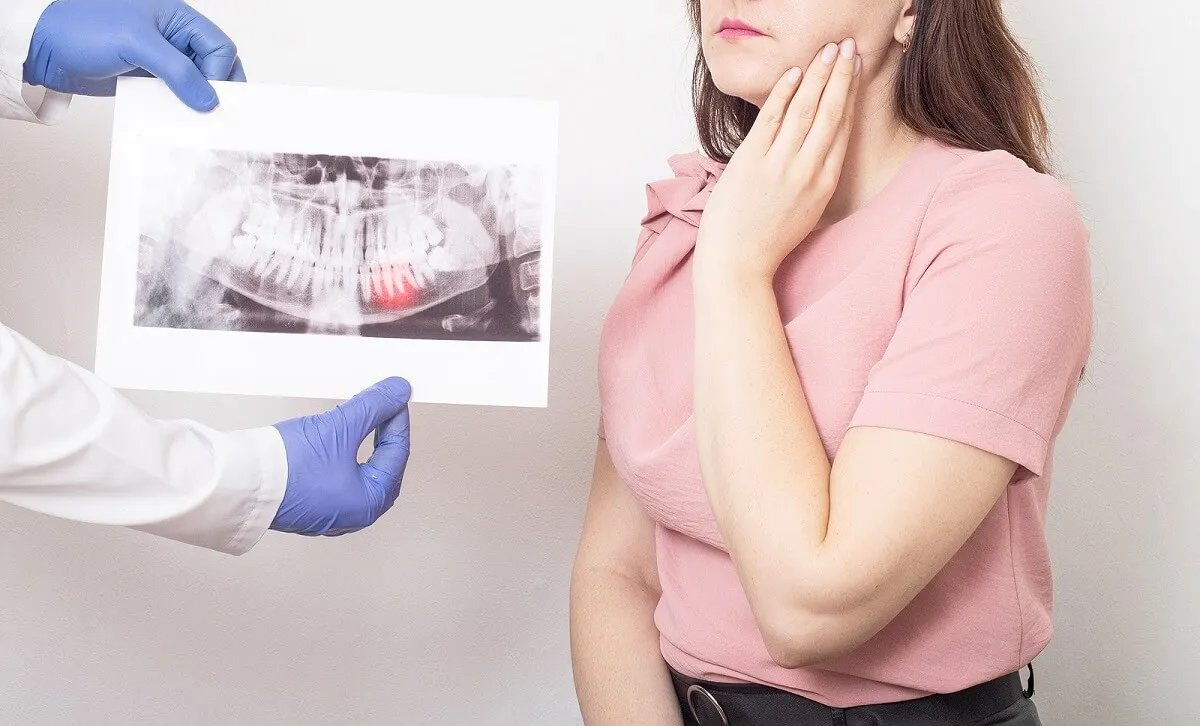Purple Gums: Causes and Treatment


Written and verified by the dentist Vanesa Evangelina Buffa
Purple gums can be a bit disturbing. In this article we tell you the reasons why your gums may turn purple and what to do if this happens.
The normal appearance of healthy gum tissue is pale pink, with a dotted texture similar to orange pe el. Its edges are sharp and precisely contour the crown of the teeth. However, sometimes it acquires a purplish tone, either by physiological or pathological situations.
The gums have the important function of covering and protecting the deep areas of the teeth from external agents. They are also part of the tissues that support and hold the teeth in place.
Paying attention to this part of the body is essential if you want to keep your teeth fixed in your mouth and avoid other health complications. So, you should know why they can turn purple and what to do about it. Let’s see.
Causes of purple gums
Purple gums can appear for different reasons. Sometimes they are due to physiological causes and do not require any special care. Other times they can be the manifestation of a more serious problem that requires immediate attention. Here are the main causes.
Dark gums
Some people have darker gums, because that is the color of their skin. The gingival tissue is naturally brownish or even purplish in color. In these cases, there is no reason for concern.
Just like the skin of the body, the color of the gums varies from person to person. People with a dark complexion tend to have darker gums or small irregular pigmentations. This is due to increased melanin production in the body and is natural.
Aging
The passage of time is another factor that can lead to purple gums. As the tissues of the body age, they undergo changes in appearance, including the coloration of the gum tissue.
In this case, the color change is characterized as uniform, throughout the thickness of the tissue. In addition, there are no other associated symptoms, such as inflammation, bleeding or pain. Although it is a natural occurrence, it is always advisable to consult a dentist to rule out associated problems .

Periodontal problems
Purple gums may be indicative of gingivitis or periodontitis. These supportive tissue disorders not only affect the appearance of gum tissue, but can also lead to tooth loss. Also,
their presence is linked to the onset and complications of systemic diseases. Diabetes, cardiac, respiratory and neurological problems are some conditions that are worsened by periodontitis. Bacterial plaque and tartar are the main causes of gingivitis and periodontitis. These debris on the oral tissues irritate the gums and cause deep infections that can destroy supporting areas and bone. Its first symptoms include
red, swollen gums that bleed easily and are painful or bothersome. If this initial stage – known as “gingivitis” – is not resolved in time, the process progresses to deeper areas and evolves into periodontitis. If so, the infection becomes deeper and deeper, there is significant destruction of supporting tissues and bone is lost. Pockets in the gum, the presence of pus, bad breath, bad taste in the mouth and mobility of the teeth are other characteristic symptoms. When the infection in the area is severe,
the gums that were inflamed, swollen and bleeding may look purplish, purple or discolored. This is not the most common and is an indication of a severe infectious process that requires immediate attention. Seeing a dentist as soon as possible is crucial to improve the prognosis. When the process has just begun, it is possible to reverse it with appropriate hygiene measures and professional cleaning. However,
if the condition progresses and is deeper, other more complex interventions will be necessary, such as scaling and root planing and periodontal surgery. It is often necessary to supplement with antibiotics and local antiseptics.
Lack of nutrients
Nutritional deficiencies, especially those related to lack of vitamins and minerals, cause manifestations in the gingival tissue. Vitamin C and iron deficiency can cause the gums to appear purple. A thorough dental check-up and questions about dietary habits will guide the dentist or physician in determining the source of this symptom.
Laboratory tests showing nutritional deficiencies will confirm the etiology of the problem.
Readjusting the diet to a more balanced diet is usually sufficient to restore gum health. However, in some cases it may be necessary to supplement with supplements of the missing nutrient.
Hormonal changes can lead to purple gums
Very red gums that take on a purple appearance may be related to a problem in the endocrine system or hormonal changes typical of some stages of life. Pregnancy, lactation and the menstrual cycle cause alterations in female hormones that can cause gingivitis and purplish coloration of the tissue. The same is true for the hormonal fluctuations associated with puberty. These changes
can occur in both women and men . The dentist may consider an evaluation with the endocrinologist to determine if there is a related hormonal disorder.
Orthodontics
Orthodontic appliances and dentures, if poorly fitted, ill-fitting and rubbing against the mucosa of the mouth, can cause injury and irritation. Traumatized gingival tissue, like any injury, will look purple and cause pain. In addition,
these attachments in the oral cavity make daily oral hygiene difficult, which favors the accumulation of bacterial plaque. This increases the chances that the gums will become inflamed and look swollen, red or purple. When wearing this type of appliance, it is important to take care of oral hygiene and attend regular dental check-ups. If it gets out of adjustment and causes an injury, you should see a dentist as soon as possible to fix it.
Oral hygiene products could be the cause of purple gums
Some people, when using toothpastes or mouthwashes that are too strong or contain certain chemicals, experience inflammation and irritation of their gums . This causes them to look purple. It can also occur if there is too frequent or exaggerated use of these types of products.
Tooth whitening agents or some plaque removal compounds can trigger this type of unwanted effect. This depends on each person’s sensitivity to the various ingredients in the products. If your gums turn purple when using certain oral hygiene supplements,
it is important to discontinue their use. In addition, you should consult your dentist to find an alternative that does not cause damage.
Medications
The use of some medications causes, as a side effect, enlargement and discoloration of the gums. Drugs to treat depression, anticonvulsants and some remedies for cardiovascular conditions can cause these manifestations in the mouth. In these cases it is important to talk to your doctor to review your medication and discuss alternatives. If the purple gums persist after changing to a different medication, it will be necessary to visit the dentist to look for the source of the problem.
Purple gums can be due to intoxication
Purple gums can be the manifestation of an intoxication with a chemical product or the bite of an animal, such as a snake. In these cases, other areas of the body such as the lips, hands and other mucous membranes often turn purple. Other symptoms such as vomiting, rash or red spots on the skin, stomach pain, bleeding and difficulty breathing may also appear. Immediate medical attention should be sought.
Tobacco
Smoking can cause discoloration of the mucous membranes of the mouth, including the gums. It is common for smokers to suffer from periodontitis and the gum tissue is inflamed and dark. In addition, there is a very common condition in these people, known as “smoker’s melanosis”. This is the change of pigmentation of the oral tissues that turn brown, purplish or black, as a
response to the irritation caused by nicotine and heat in the mouth. It is common to observe darkened gums, palate and cheeks. Smoking is also associated with oral cancer.
As we will tell you later, malignant lesions in the gums can cause them to turn purple. If you are a smoker and notice that your gums are purple or black, you should visit your dentist immediately. Also, you may want to consider quitting smoking.
Read All About Gums: What They Do and How to Look After Them
Oral cancer
Although not the most common, purple gums can be an indication of the presence of a dangerous cancer called “oral malignant melanoma”. This looks like a tan, brown, red, purple, gray or bluish-black spot on the gum tissue. It can be found anywhere in the mouth, including the gums. Its shape and size change as the lesion progresses and grows.
Although it is a rare disease, it can be fatal. For this reason, any suspicion should be treated immediately.
Treatments can be surgical, with chemotherapy or radiotherapy, depending on the degree and prognosis of the lesion.
Treatments for purple gums
The treatment to solve purple gum problems depend on the cause that caused the change in coloration. As we have already mentioned, it is essential to go to the dentist so that the professional can determine the origin of the condition and the most indicated therapy. These are some of the procedures that can help restore the appearance and health of the gingival tissue:
- Professional cleaning: removing bacterial plaque and tartar deposits is a good preventive treatment for periodontal problems in their initial stages.
- Warm salt water rinses: if the purple color is due to inflammation, warm salt water rinses help clean the mouth and reduce the condition.
- Scaling and root planing: when periodontal disease is more advanced, this treatment can remove pockets, infection and tartar deposits from deeper areas.
- Gingival grafts: to repair damaged gums or to hide purple pigmentation for esthetic purposes, a graft can be performed. Through a surgical intervention, a healthy tissue taken from the palate is placed on the gingival area.
- Balanced diet: a varied diet containing fruits, vegetables, meats and cereals helps to compensate for nutritional deficiencies and reduce the purple color of the gums.
- Correcting external factors: if the purple gums are due to orthodontic appliances, dentures, oral hygiene products or medications, by correcting, removing or replacing these external causes, the gums can recover.
- Microabrasion or scalpel: this is a cosmetic treatment that consists of eliminating the pigmentation of the superficial layer of the gums so that they recover a more esthetic appearance.

How to prevent purple gums?
One of the best ways to avoid gingival problems is through proper oral hygiene. By using a toothbrush, fluoride toothpaste and dental floss properly, it is possible to reduce the risk of gums becoming inflamed and turning purple. It is also advisable to avoid sweets, soft drinks and ultra-processed foods that favor the proliferation of bacteria.
Quitting smoking is another important aspect. This change not only protects the mouth and reduces the risk of oral cancer, but also benefits the whole body. Finally, it is essential to visit the dentist every 6 months, or sooner if necessary. The professional will be able to detect any problems that arise in the mouth to find a timely solution.
When in doubt, consult the dentist
Purple gums may be due to benign causes or problems but you can reverse it with some simple care. However, they can also be a symptom of a more dangerous problem, such as oral cancer. If you notice a change of color in any part of your mouth, it is
best to consult your dentist early. The intervention of the professional will allow you to reach an accurate diagnosis and make the most appropriate treatment.
All cited sources were thoroughly reviewed by our team to ensure their quality, reliability, currency, and validity. The bibliography of this article was considered reliable and of academic or scientific accuracy.
- Moscoso, A. C., & Lara, M. D. R. B. (2020). Presentación clínica de pigmentación melánica fisiológica. Revista de la Asociación Dental Mexicana, 77(4), 227-230.
- Bolaños, O. M. M. (2010). Envejecimiento bucodental. Anales en Gerontología, 6(6), 59-67.
- Sojod, B., Périer, J. M., Zalcberg, A., Bouzegza, S., El Halabi, B., & Anagnostou, F. (2022). Enfermedad periodontal y salud general. EMC-Tratado de Medicina.
- Machtei, E. E., Mahler, D., Sanduri, H., & Peled, M. (2004). The effect of menstrual cycle on periodontal health. Journal of periodontology, 75(3), 408-412.
- Vereau, N. C., & Palacios, M. A. (2012). Enfermedad gingival en adolescentes: Diagnóstico y tratamiento. Revista Estomatológica Herediana, 22(3), 167-170.
- Secumbino, M. B. J. (2021). El tabaquismo y su asociación con la salud bucal (Bachelor’s thesis).
- Vigil, F. J. D. L., Carapia, E. A., Garcia, Z. F., & Anaya, Y. B. (2021). Hiperplasia gingival farmacoinducida. Revista Tamé, 8(26), 1056-1059.
- Valerdi, M. L., Resendiz, J., Labastida, S., Gallegos, F., & Kimura, T. (2018). Melanoma primario en mucosa de cavidad bucal. Oral, 18(58), 1526-1529.
- Vega Godoy, S. A. (2022). Tabaquismo como factor causal del cáncer oral. Revisión de literatura.
- Espinoza Ortiz, E. (2019). Factores de riesgo en pacientes con cáncer oral (Bachelor’s thesis, Universidad de Guayaquil. Facultad Piloto de Odontología).
This text is provided for informational purposes only and does not replace consultation with a professional. If in doubt, consult your specialist.








